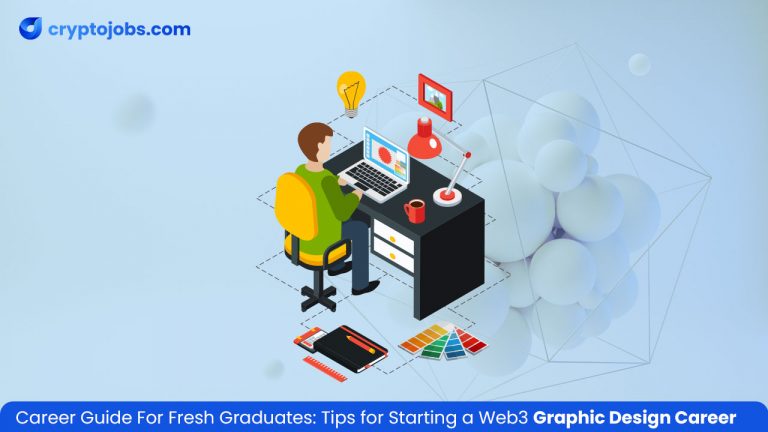
Tips for Starting a Web3 Graphic Design Career
- cryptojobs.com
- April 16, 2024
- All Posts, Career Guide
- Web3
- 0 Comments
There are countless opportunities to create immersive user experiences, dynamic visual identities, or revolutionary digital marketing campaigns in the field of graphic design. The need for visually striking material is growing as organizations negotiate the complexity of the digital world, offering recent graduates a variety of options to start fulfilling careers as Web3 graphic designers. If you are considering a career in this exciting profession where cutting-edge technology and creativity collide, you have come to the right spot.
This article will act as your guide, providing insightful analysis and useful advice on how to get started as a Web3 graphic designer and find your niche in the cutthroat field of graphic design.
Step 1: Lay the Groundwork
It is important to set a solid foundation before diving headfirst into the world of graphic design. Learn the foundational concepts of:
- Composition
- Typography
- Color theory
- Design
Take online classes, read books, and watch tutorials to broaden your knowledge and gain technical proficiency. Software proficiency is similarly important. Therefore, focus on studying the most popular design programs, such as:
- Adobe Photoshop
- Adobe Illustrator
- InDesign
Step 2: Craft a Compelling Portfolio
A portfolio acts as a significant tool for impressing potential employers, serving as a representation of your skills and knowledge. Start by assembling a website for your portfolio or using sites like Behance or Dribbble to showcase your best work. Choose works that exhibit your inventiveness and adaptability to a range of design tasks in addition to displaying your technical skills. Make sure the work in your portfolio is varied and encompasses a variety of genres, materials, and methods.
Check out: 8 Essential Web3 Graphic Designer Skills That Make Your Resume Standout
Give each project some context as well, including details about your approach to problem-solving, design process, and work’s overall impact. By developing a compelling portfolio that clearly conveys your abilities and expertise, you may attract employers’ attention and open doors to fulfilling career prospects in the industry.
Step 3: Forge Connections
In the ever-changing field of graphic design, building a strong professional network is essential. Engage with other designers and industry professionals by going to design conferences, seminars, and local events. Collaborating with fellow designers or becoming involved in design communities may provide priceless insights and promote individual development. You can increase your chances and build enduring partnerships that support your ascent to success in the graphic design sector by actively networking and working together within the design community.
Step 4: Keep up with Trends
Adopt a proactive stance and learn from seasoned experts and thought leaders by:
- Reading and watching blogs and magazines that are leading the field
- Going to conferences.
- Attending seminars.
Participating in online graphic design groups offers a way to share information and learn new things all the time. Staying abreast of industry developments allows you to capitalize on new methods and adjust to new trends, keeping your skill set current and your work appealing to modern consumers.
Check out: 10 Graphic Design Trends That Will Dominate the Web3 Industry in 2024
Step 5: Learn to Manager Clients
Success in the fast-paced field of graphic design is mostly dependent on professionalism and efficient client handling. It is crucial to have good communication skills so that you can:
- Understand what the customer needs.
- Ask pertinent questions.
- Give frequent updates on the status of the project.
Throughout the design process, it is critical to establish realistic timeframes, communicate openly, and set clear expectations. These actions promote mutual understanding and trust.
Furthermore, developing a solid reputation in the field depends on producing consistently excellent work and providing outstanding customer service. Prioritizing customer satisfaction and exhibiting unshakable professionalism help you establish yourself as a reliable designer and open the door to gaining lucrative recommendations and repeat business.
Step 6: Choose Your Employment Path
One of the most important decisions you will face while starting your graphic design career is choosing between standard employment and freelance work. With the unmatched freedom and flexibility that comes with freelancing, you may choose your own hours, take on a variety of assignments, and establish your own fees.
However, there are benefits associated with looking for graphic design jobs at agencies, startups, or large businesses. Jobs provide security, a reliable source of income, and chances for career advancement. Collaborating in a group setting encourages:
- Mentoring
- Teamwork
- Opportunity to participate in bigger initiatives
Are you prepared to advance in your profession as a graphic designer? Cryptojobs.com provides a platform that is suited to your requirements, regardless of whether you are drawn to the steadiness of regular work or the flexibility of freelancing.




